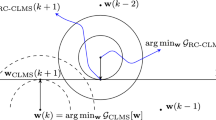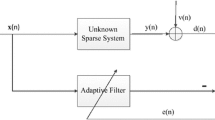Abstract
In this work, we propose an adaptive set-membership (SM) reduced-rank filtering algorithm using the constrained constant modulus criterion for beamforming. We develop a stochastic gradient type algorithm based on the concept of SM techniques for adaptive beamforming. The filter weights are updated only if the bounded constraint cannot be satisfied. We also propose a scheme of time-varying bound and incorporate parameter dependence to characterize the environment for improving the tracking performance. A detailed analysis of the proposed algorithm in terms of computational complexity and stability is carried out. Simulation results verify the analytical results and show that the proposed adaptive SM reduced-rank beamforming algorithms with a dynamic bound achieve superior performance to previously reported methods at a reduced update rate.







Similar content being viewed by others
Explore related subjects
Discover the latest articles and news from researchers in related subjects, suggested using machine learning.Notes
ULA is considered for the sake of simplifying the presentation, while generalization to other antenna configurations is straightforward.
For the proposed algorithm with the fixed bound scheme, the convergence factor is the bound \(\gamma \). For the proposed algorithm with the time-varying bound scheme, the convergence factors are the tuning coefficients \(\rho \) and \(g\). The relationships between the convergence factors and the step-size values are shown in expressions (20), (21) and (22).
References
Anderson, S., Millnert, M., Viberg, M., & Wahlberg, B. (1991). An adaptive array for mobile communication systems. IEEE Transactions on Vehicular Technology, 40(1), 230–236.
Boray, G. K., & Srinath, M. D. (1992). Conjugate gradient techniques for adaptive filtering. IEEE Transactions on Circuits and Systems I: Fundamental Theory and Applications, 39(1), 1–10.
Burykh, S., & Abed-Meraim, K. (2002). Reduced-rank adaptive filtering using Krylov-subspace. EURASIP Journal on Applied Signal Processing, 2002(1), 1387–1400.
Cao, J. (2014, July 28–30). Survey on acoustic vector sensor and its applications in signal processing. In Proceedings of the 33rd Chinese control conference (CCC2014), Nanjing, China, pp. 7456–7461.
Cai, Y., & de Lamare, R. C. (2009). Low-complexity variable step-size mechanism for code-constrained constant modulus stochastic gradient algorithms applied to CDMA interference suppression. IEEE Transactions on Signal Processing, 57(1), 313–323.
Cai, Y., & de Lamare, R. C. (2013). Adaptive linear minimum BER reduced-rank interference suppression algorithms based on joint and iterative optimization of filters. IEEE Communications Letters, 17(4), 633–636.
Cai, Y., de Lamare, R. C., Zhao, M., & Zhong, J. (2012). Low-complexity variable forgetting factor mechanism for blind adaptive constrained constant modulus algorithms. IEEE Transactions on Signal Processing, 60(8), 3988–4002.
Cao, J. A., Khong, W. H., & Gannot, S. (2014, September 8–11). On the performance of widely linear Quaternion based MVDR beamformer for an acoustic vector sensor. In Proceedings of the international workshop on acoustic signal enhancement (IWAENC 2014), Juan les Pins, French Riviera, pp. 304–308.
Cao, J., & Lin, Z. (2014). Bayesian signal detection with compressed measurements. Information Sciences, 289, 241–253.
Chang, P. S., & Willson, A. N. (2000). Analysis of conjugate gradient algorithms for adaptive filtering. IEEE Transactions on Signal Processing, 48(2), 409–418.
de Lamare, R. C., & Diniz, P. S. R. (2013). Blind adaptive interference suppression based on set-membership constrained constant-modulus algorithms with dynamic bounds. IEEE Transactions on Signal Processing, 61(5), 1288–1301.
de Lamare, R. C., Haardt, M., & Sampaio-Neto, R. (2008). Blind adaptive constrained reduced-rank parameter estimation based on constant modulus design for CDMA interference suppression. IEEE Transactions on Signal Processing, 56(6), 2470–2482.
de Lamare, R. C., & Sampaio-Neto, R. (2005). Blind adaptive code-constrained constant modulus algorithms for CDMA interference suppression in multipath channels. IEEE Communications Letters, 9(4), 334–336.
de Lamare, R. C., & Sampaio-Neto, R. (2005). Adaptive reduced-rank MMSE filtering with interpolated FIR filters and adaptive interpolators. IEEE Signal Processing Letters, 12(3), 177–180.
de Lamare, R. C., & Sampaio-Neto, R. (2007). Reduced-rank adaptive filtering based on joint iterative optimization of adaptive filters. IEEE Signal Processing Letters, 14(12), 980–983.
de Lamare, R. C., & Sampaio-Neto, R. (2009). Adaptive reduced-rank processing based on joint and iterative interpolation, decimation, and filtering. IEEE Transactions on Signal Processing, 57(7), 2503–2514.
de Lamare, R. C., & Sampaio-Neto, R. (2010). Reduced-rank space–time adaptive interference suppression with joint iterative least squares algorithms for spread-spectrum systems. IEEE Transactions on Vehicular Technology, 59(3), 1217–1228.
de Lamare, R. C., Sampaio-Neto, R., & Haardt, M. (2011). Blind adaptive constrained constant-modulus reduced-rank interference suppression algorithms based on interpolation and switched decimation. IEEE Transactions on Signal Processing, 59(2), 681–695.
de Lamare, R. C., Wang, L., & Fa, R. (2010). Adaptive reduced-rank LCMV beamforming algorithms based on joint iterative optimization of filters: design and analysis. Signal Processing, 90, 640–652.
Diniz, P. S. R. (2002). Adaptive filtering: Algorithms and practical implementations (2nd ed.). Boston, MA: Kluwer.
Fa, R., & de Lamare, R. C. (2011). Reduced-rank STAP algorithms using joint iterative optimization of filters. IEEE Transactions on Aerospace and Electronic Systems, 47(3), 1668–1684.
Ge, H., Kirsteins, I. P., & Scharf, L. L. (2006, May). Data dimension reduction using Krylov subspaces: Making adaptive beamformers robust to model order-determination. In: 31st IEEE international conference on acoustics, speech and signal processing, Vol. 4, Toulouse, France, pp. 1001–1004.
Gierull, C. H. (1997). Statistical analysis of the eigenvector projection method for adaptive spatial filtering of interference. IEE Proceedings on Radar, Sonar and Navigation, 144(2), 57–63.
Goldstein, J. S., & Reed, I. S. (1997). Reduced-rank adaptive filtering. IEEE Transactions on Signal Processing, 45(2), 492–496.
Goldstein, J. S., & Reed, I. S. (1997). Subspace selection for partially adaptive sensor array processing. IEEE Transactions on Aerospace and Electronic Systems, 33(2), 539–544.
Goldstein, J. S., Reed, I. S., & Scharf, L. L. (1998). A multistage representation of the Wiener filter based on orthogonal projections. IEEE Transactions on Information Theory, 44(11), 2943–2959.
Gollamudi, S., Nagaraj, S., & Huang, Y. F. (2000, June). Blind equalization with a deterministic constant modulus cost—A set-membership filtering approach. In Proceedings of the IEEE international conference on acoustics speech, signal processing (ICASSP), Vol. 5, pp. 2765–2768.
Gollamudi, S., Nagaraj, S., & Huang, Y. F. (1998). Set-membership filtering and a set-membership normalized LMS algorithm with an adaptive step size. IEEE Signal Processing Letters, 5(5), 111–114.
Golub, G. H., & van Loan, C. F. (2002). Matrix computations. New York: Wiley.
Guerci, J. R., Goldstein, J. S., & Reed, I. S. (2000). Optimal and adaptive reduced-rank STAP. IEEE Transactions on Aerospace and Electronic Systems, 36(2), 647–663.
Haimovich, A. M., & Bar-Ness, Y. (1991). An eigenanalysis interference canceler. IEEE Transactions on Signal Processing, 39(1), 76–84.
Haykin, S. (2002). Adaptive filter theory (4th ed.). Englewood Cliffs, NJ: Prentice-Hall.
Hong, M., Madhow, U., & Verdu, S. (1995). Blind adaptive multiuser detection. IEEE Transactions on Information Theory, 41(4), 944–960.
Honig, M. L., & Xiao, W. (2001). Performance of reduced-rank linear interference suppression. IEEE Transactions on Information Theory, 47(5), 1928–1946.
Honig, M. L., & Goldstein, J. S. (2002). Adaptive reduced-rank interference suppression based on the multistage Wiener filter. IEEE Transactions on Communications, 50(6), 986–994.
Johnson, D. H., & Dudgeon, D. E. (1993). Array signal processing: Concepts and techniques. Englewood Cliffs, NJ: Prentice-Hall.
Kirsteins, I. P., & Ge, H. (2006, July). Performance analysis of Krylov space adaptive beamformers. In 4th IEEE workshop on sensor array and multichannel processing, Waltham, MA, pp. 16–20.
Li, J., & Stoica, P. (2006). Robust adaptive beamforming. Hoboken, NJ: Wiley.
Liu, Y., & Lin, Z. (2006). On the applications of the frequency-response masking technique in array beamforming. Circuits, Systems and Signal Processing, 25(2), 201–224.
Nagaraj, S., Gollamudi, S., Kapoor, S., & Huang, Y. F. (1999). BEACON: An adaptive set-membership filtering technique with sparse updates. IEEE Transactions on Signal Processing, 47(11), 2928–2941.
Pados, D. A., & Batalama, S. N. (1999). Joint space–time auxiliary vector filtering for DS/CDMA systems with antenna arrays. IEEE Transactions on Communications, 47(9), 1406–1415.
Pados, D. A., & Karystinos, G. N. (2001). An iterative algorithm for the computation of the MVDR filter. IEEE Transactions on Signal Processing, 49(2), 290–300.
Scharf, L. L., Chong, E. K. P., Zoltowski, M. D., Goldstein, J. S., & Reed, I. S. (2008). Subspace expansion and the equivalence of conjugate direction multistage Wiener filters. IEEE Transactions on Signal Processing, 56(10), 5013–5019.
Somasundaram, S. D., Li, P., Parsons, N. H., & de Lamare, R. C. Reduced-dimension robust capon beamforming using Krylov-subspace techniques. IEEE Transactions on Aerospace and Electronic Systems (to appear).
Van Trees, H. L. (2004). Detection, estimation, and modulation theory, part IV, optimum array processing. New York: Wiley.
Wang, L., & de Lamare, R. C. (2012). Set-membership constrained conjugate gradient adaptive algorithm for beamforming. IET Signal Processing, 6(8), 789–797.
Wang, L., & de Lamare, R. C. (2013). Low-complexity constrained adaptive reduced-rank beamforming algorithms. IEEE Transactions on Aerospace and Electronic Systems, 49(4), 2114–2128.
Weippert, M. E., Hiemstra, J. D., Goldstein, J. S., & Zoltowski, M. D. (2002, August 4–6). Insights from the relationship between the multistage Wiener filter and the method of conjugate gradients. In Proceedings of the IEEE workshop on sensor array multichannel signal processing, pp. 388–392.
Werner, S., & Diniz, P. S. R. (2001). Set-membership affine projection algorithm. IEEE Signal Processing Letters, 8(8), 231–235.
Whitehead, J., & Takawira, F. (2005). Performance analysis of the linearly constrained constant modulus algorithm-based multiuser detector. IEEE Transactions on Signal Processing, 53(2), 643–653.
Widrow, B., & Lehr, M. (1990). 30 Years of adaptive neural networks: Perceptron madaline and backpropagation. Proceedings of the IEEE, 78(9), 1415–1442.
Xu, Z., & Tsatsanis, M. K. (2001). Blind adaptive algorithms for minimum variance CDMA receivers. IEEE Transactions on Communications, 49(1), 180–194.
Xu, C., Feng, G., & Kwak, K. S. (2001). A modified constrained constant modulus approach to blind adaptive multiuser detection. IEEE Transactions on Communications, 49(9), 1642–1648.
Zeng, H., Tong, L., & Johnson, C. R. (1998). Relationships between the constant modulus and Wiener receivers. IEEE Transactions on Information Theory, 44(4), 1523–1538.
Zou, Q., Yu, Z., & Lin, Z. (2004). A robust algorithm for linearly constrained adaptive beamforming. IEEE Signal Processing Letters, 11(1), 26–29.
Acknowledgments
The authors would like to thank Prof. Rodrigo C. de Lamare for his insightful suggestions which have helped to improve the quality of this contribution.
Author information
Authors and Affiliations
Corresponding author
Additional information
This work was supported by the National Natural Science Foundation of China under Grants 61101103 and 61471319, the Fundamental Research Funds for the Central Universities, and the Zhejiang Provincial Natural Science Foundation of China under Grant LY14F010013.
Appendix: Derivation for (20) and (21)
Appendix: Derivation for (20) and (21)
In this appendix, we derive the expressions in (20) and (21). Note that each constraint set comprises of two parallel hyperstrips in the parameter space. Based on the constraint \(e^2(i)>\gamma ^2(i)\), we consider the following two cases for update: (1) \(|y(i)|>\sqrt{1+\gamma (i)}\) and (2) \(|y(i)|<\sqrt{1-\gamma (i)}\). Firstly, let us focus on the variable step-size \(\mu _{p}(i)\). We obtain \(\mu _{p}(i)\) for computing \(\mathbf {p}(i+1)\) by projecting \(\mathbf {p}(i)\) onto \(\mathcal {H}_{p}(i)\), i.e., the set of all \(\mathbf {p}\) that satisfy:
For case 1) \(|\bar{\mathbf {w}}^{H}(i)\mathbf {T}\mathbf {R}^{'}(i)\mathbf {p}^{*}(i)|>\sqrt{1+\gamma (i)}\), \(\mathbf {p}(i)\) is closer to the hyperplanes defined by
than to the ones defined by
By substituting (18) into (31) and using the constraint \(\bar{\mathbf {w}}^{H}(i)\mathbf {T}\mathbf {D}(\theta _{0})\mathbf {p}^{*}(i)=\nu \) we have
By making an arrangement to (33) we have the following expression:
For case 2) \(|\bar{\mathbf {w}}^{H}(i)\mathbf {T}\mathbf {R}^{'}(i)\mathbf {p}^{*}(i)|<\sqrt{1-\gamma (i)}\), \(\mathbf {p}(i)\) is closer to the hyperplanes defined by (32). By following the same approach we have:
Therefore, the expressions for \(\mu _{p}(i)\) can be summarized as (20).
Then, we derive the expression for the variable step-size \(\mu _{w}(i)\). By employing (19) we have the following expression
Similarly, by considering these two cases to update and making the arrangement to (36), we can obtain (21).
Rights and permissions
About this article
Cite this article
Cai, Y., Qin, B. & Zhang, H. An improved adaptive constrained constant modulus reduced-rank algorithm with sparse updates for beamforming. Multidim Syst Sign Process 27, 321–340 (2016). https://doi.org/10.1007/s11045-014-0304-5
Received:
Revised:
Accepted:
Published:
Issue Date:
DOI: https://doi.org/10.1007/s11045-014-0304-5




